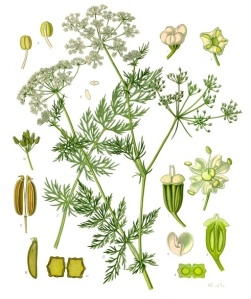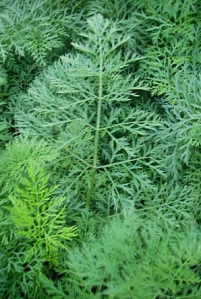It’s been a while since I had a foraging-themed post, but a lovely trip through Redwood Regional Park in Oakland with JYL and TC two weekends ago yielded some good material. JYL has a fantastic foodie blog (willblogforfood), and she’s posted a nice slideshow of all our various wild food sightings that you should check out, with some great pics from her macro lens.
To recap some highlights, we saw berry plants in abundance (thimbleberries, red-flowered currants, blackberries, and wild strawberries), but while the strawberries, blackberries and currants were in flower, nothing was yet in fruit. So stay tuned for a follow-up post when we make a return foraging trip to collect those guys in June.
Bay trees were everywhere, some in flower. We saw lots of mustard, and gathered some greens from that, and quite a few young fiddlehead ferns. A few things that I was certain we would see, some of the guarantees of California wild food, were surprisingly absent: namely fennel, wild radishes, and oxalis/sorrel (even though we went to Redwood park specifically because I was sure we’d see redwood sorrel! We found it in a random yard instead). Since I’ve posted about all those things before, no harm done.
The highlight of the foraging was probably miner’s lettuce (Claytonia perfoliata, also sometimes called winter purslane), which was rampant along the side of the trail.

Miner's lettuce, Calytonia perfoliata. The large, round, single leaves (bracts) with small white flowers in the center are unmistakeable. Photo courtesy of Jen Lee at willblogforfood.
I grew up eating its distinctive, spinach-like leaves (actually bracts, to the botanists) as a kid, but in San Diego and Riverside counties they were usually the size of a quarter. After the bouts of late rain we’ve had this spring, the bracts at Redwood park (and also all around Stanford), are nearly the size of my palm. They also have great texture–delicate and juicy just like young spinach, but with a milder flavor. I gathered a large ziploc full of the stuff, and brought it home to try out on my husband, who turned out to be a big fan.

Miner's lettuce washed and ready to eat!
Miner’s lettuce is easy to recognize as a plant: the round, cuplike bracts emerge singly from the basal rosette on long stems up to 10″ long, and centered on the top of each bract is a small stem bearing a little cluster of white flowers (the true leaves are thin and triangular, and hide out in the basal rosette at the bottom of the plant). The whole plant is edible, but under rare conditions they can accumulate toxic oxalates, so as with any wild plant, after positive identification you should eat small amounts first until you know how it will make you feel. I’ve eaten lots of this stuff from several counties across California, and find it to be one of the most palatable and reliable raw wild greens. It’s high in vitamin C–the gold rush miners for whom it’s named ate it to prevent scurvy. Miner’s lettuce favors damp places with high to intermediate shade and poorly drained soil. Roadsides in shady areas are a good bet, or in moist back yards.
We separated the bracts from the stems and washed them thoroughly, and used them in place of lettuce in a couple salads and also in chicken tacos. There’s still a huge amount of miner’s lettuce growing around campus right now, so I plan to bring home more while it lasts.

Chicken tacos with cheese, homemade pico de gallo and miner's lettuce. Delicious!
Bon apetit!



























